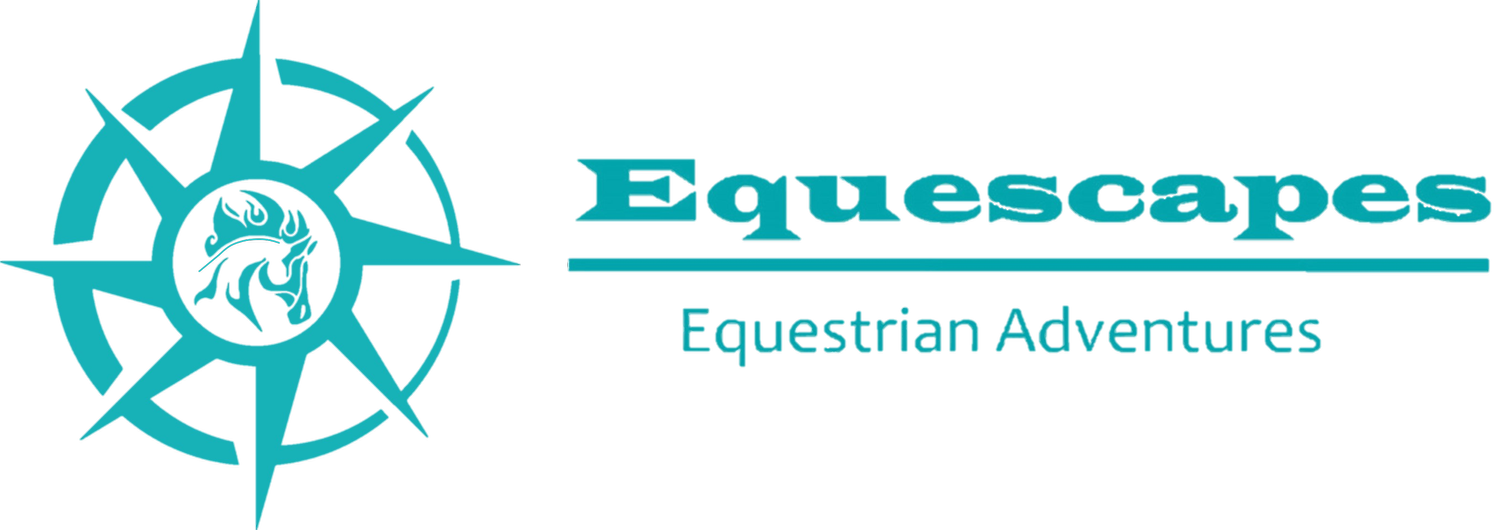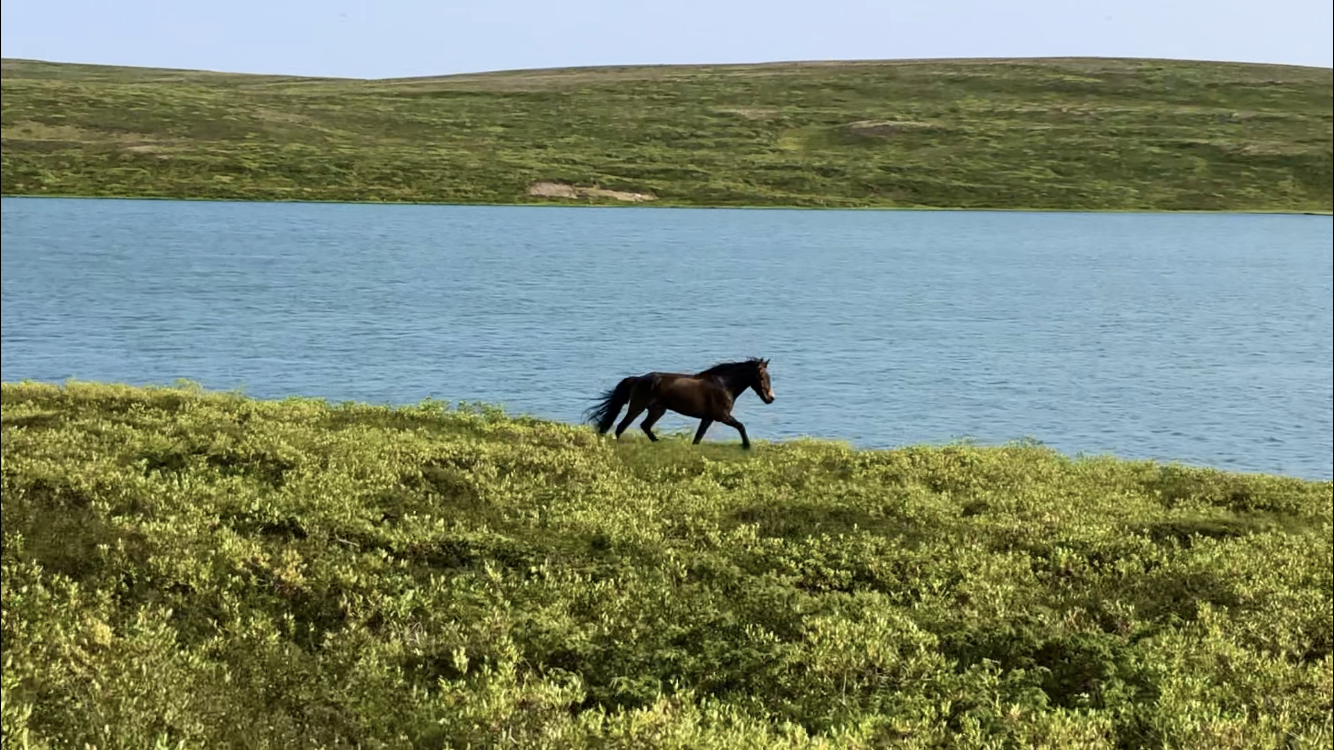The pitter-patter of 1,000 hoofbeats are muffled by the vast, vibrant landscape. From black sand beaches, you catch glimpses of distant glaciers, towering cliffs where birds swoop and dive, and glittering waterfalls running miles down mountain sides. Small, red-roofed farms dot the seam where the plain ends and the cliffs begin, rivulets gushing down the cliff sides like tears on many craggy cheeks. The landscape passes almost too fast to catch it all; the horses and the path in front of us absorb so much of our attention that each time we remember to look up and look around, we see a whole new landscape. It changes before our eyes as we seem to fly across it, a cloud of dust drifting in our wake into the cloudless blue sky.
There is no better way to see this rugged, ethereal terrain than from the saddle, mounted on a marvelous Icelandic horse whose surefootedness carries us across rivers, through lava fields, over mountains, up and down valleys, and along stretches of dark coast.
The Icelandic Horse
Though they are small, don’t let the Icelanders hear you call them ponies – they take great pride in their horses, who to them, are as large and as mighty as the best of them.
The circumstances of the Icelandic horse are as unique as the breed itself, which is the only breed of horse to inhabit the whole of Iceland. Since arriving with Norse settlers over 1,000 years ago, the Icelandic breed has been isolated on the island – no other horses may be imported, and Icelandic horses who leave may never return. The purity of the breed keeps these horses free of diseases and exceptionally healthy – the average lifespan of an Icelandic horse is 40 years! They are incredibly well-adapted to the harsh climate, treacherous footing, and high winds.
There are no colors the Icelandic horse doesn’t come in – throughout my trip, nearly every time I passed a field full of horses, there was at least one in a color I hadn’t seen yet. Known for their luscious manes and tails, their locks blowing in the wind often hold many colors at once.
Riding Icelandic Horses
Icelandic horses are short in stature, gentle in nature, nimble, hardy, and just a dream to ride. They are the only breed of horse to have five gaits – they can walk, trot, and canter, but the gait we ride the most is the tölt, a four-beat lateral gait, exceptionally smooth and easy to ride, at which the horse can reach speeds of up to 20 miles per hour (32 kilometers per hour). This is how the Icelandic horse covers so much ground – they move along comfortably in this gait, not slowing down to go up or down hills, over rocks, or through uneven terrain. Finally, the skeið, or flying pace, is a two-beat lateral gait that can reach up to 30 miles per hour (48 kilometers per hour) and truly feels like flying.
Each day we changed horses at least once, giving all the riders the opportunity to try out various horses. The guide would hand me a horse and tell me his name - something I completely couldn’t pronounce. The first day, I called my horse Steve, but the next day, I got another horse whose name I couldn’t pronounce either. I called them all Steve - Rasta Steve (one of my favorites) had one huge dreadlock in his tail, Sumo Steve was very rotund but full of fire, Mocha Steve was a dark grullo/bay, with gray streaks in his black mane. We all liked some horses better than others, but none ever really gave us any trouble. None ever spooked, bucked, or bolted – the worst stunt they would pull was to trot instead of tölt, making for a less comfortable but still very tranquil ride.
Special saddles are designed for Icelandic horses. Similar to dressage saddles, they place the rider in a comfortable seat and allow for greater range of motion in the horses’ shoulders’ by sitting quite far back. Every horse rode in a simple snaffle with a noseband over the top – we got a different bridle with each horse but were instructed to keep our highly-prized nosebands with our saddles, something that baffled and amused us throughout the week.
Trekking with a Loose Herd
Over the course of 6 days, we moved around 50-60 horses over 100 miles. Between a dozen riders, a few at the front and the rest at the back, we steered the herd across rivers and lakes, fields and farms, up and down mountains and valleys, and right through the hearts of several small towns.
I spent the duration riding at the front. It was our job not to let any of the horses pass the mounted riders, and every day the same horses would try. Three horses in particular, all black, led by one of our guide Hreinn’s personal horses, a black gelding with a flowing mane, would always find their way to the front and attempt to pass the leaders. We picked up speed, sometimes moving as fast as a flying pace, to stay ahead and keep the horses back until they settled back into the herd. All the horses followed willingly, never wishing to leave the herd, except on one occasion. We were stopping for lunch alongside a river and most riders had already dismounted, when a small band of horses decided to turn around and head for home, despite the fast that we were already two days riding from the farm. Hlynur, the son of our head guide, rode off after them, single-handedly turning the herd around and bringing every single one back.
Some stops were fenced, although I use the word ‘fence’ lightly. A thin string was loosely hung between thin posts, maybe two and a half feet off the ground. We would herd the whole herd into the makeshift paddock, packed like sardines, and never once would any of them give the fence any trouble. This was a testament to the docile nature of these horses.
Land of the Midnight Sun
Leaving the horses in a new place each night, the van would meet us there to return to the guesthouse, where we enjoyed a soak in the hot tub before home-cooked dinners each evening. Mornings consisted of tea and coffee, plain oatmeal and toast for breakfast, and packing our sandwiches into saddle bags for the day’s ride. It was late summer, the sun rising around 7am and setting around 9pm, very similar to home. However, in June and July, the sunlight lasts almost 24 hours in Iceland, which is nearly on the Arctic circle. Known as the Land of the Midnight Sun, in the middle of summer the sun barely dips below the horizon for a few hours at night, but it remains light out all night long.
Although we covered 20-30 miles per day (30-45 kilometers), traveling at tölt speed we only rode 3-5 hours, with several breaks along the way to change horses, gobble snacks, and take in the scenery. The weather was perfect, cloudless blue skies reflected in the alpine lakes surrounding us, with the sun on our faces.
Except for the flies. That, we were not prepared for. The first day we didn’t experience them at all. The second day, we crossed the first river and then they began, at first just a nuisance, and then became a full-blown challenge. Some riders (better prepared than we were, clearly) had face nets over their helmets to protect their faces. I rode with a cloth buff pulled up over my mouth and nose and sunglasses, which helped immensely but didn’t fully prevent them from flying into my eyes, ears, mouth, and nose. One rider used a mesh laundry bag over her head, a highly effective improvised solution. At the end of each day I would blow my nose to find dozens of flies, and I swear I had one in my ear that didn’t come all the way out until after I had returned home. The flies didn’t seem to bother the horses or our Icelandic guides whatsoever, much to our amazement. But, it beat riding at the back of the line where riders had to deal with the flies and all the dust kicked up by the whole herd as we traversed arid sections of desert and dirt trails.
Until Next Time
There is something truly special about the kinds of friendships you make on a trip like this. You share wonder and amazement at the desolate, dreamy landscape, commiserate over sore backsides and flies in your eyes, and bond over stories and laughs at the dinner table. You never know who you might meet on a trip like this - our group consisted of myself and a friend, a mother and two grown daughters from Sweden, one Brit, and several other Americans. The staff were all Icelanders, except the cook, who was German. A few of the riders had been to Iceland before, and all left wanting to come back again someday.
Learn more about our Iceland Riding Trips and join us in the Land of the Midnight Sun!






